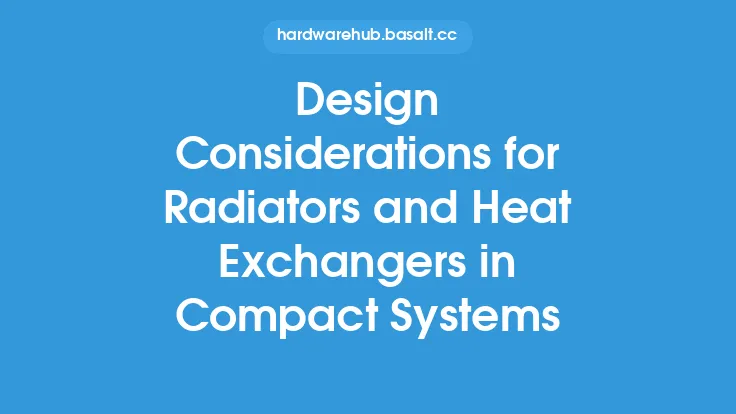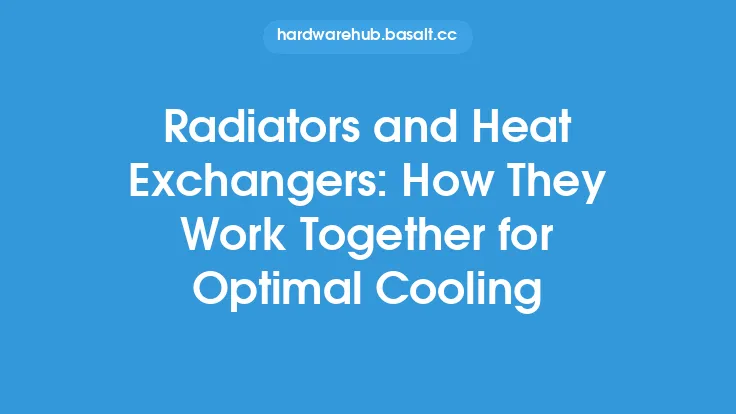Data centers are facilities that house a large number of servers, storage systems, and other IT equipment, which generate a significant amount of heat. This heat must be removed efficiently to prevent equipment failure, reduce downtime, and ensure reliable operation. One of the most effective ways to cool data centers is by using radiators and heat exchangers. These cooling solutions play a critical role in maintaining a stable temperature and humidity level, which is essential for the optimal performance of IT equipment.
Introduction to Radiators and Heat Exchangers
Radiators and heat exchangers are designed to transfer heat from one medium to another, typically from water or a refrigerant to air. In data centers, they are used to cool the hot air generated by servers, storage systems, and other IT equipment. Radiators are typically used in air-side cooling systems, where they are used to cool the air directly. Heat exchangers, on the other hand, are used in liquid-side cooling systems, where they are used to transfer heat from the liquid coolant to a secondary coolant or to air.
Types of Radiators and Heat Exchangers
There are several types of radiators and heat exchangers used in data centers, each with its own advantages and disadvantages. Some of the most common types include:
- Plate-fin radiators: These are the most common type of radiator used in data centers. They consist of a series of plates and fins that are used to transfer heat from the air to a liquid coolant.
- Tube-fin radiators: These radiators use a series of tubes and fins to transfer heat from the air to a liquid coolant.
- Coil radiators: These radiators use a coil of tubes to transfer heat from the air to a liquid coolant.
- Plate heat exchangers: These heat exchangers use a series of plates to transfer heat from one liquid to another.
- Shell-and-tube heat exchangers: These heat exchangers use a shell and tube design to transfer heat from one liquid to another.
Design Considerations for Radiators and Heat Exchangers
When designing a radiator or heat exchanger for a data center, there are several factors that must be considered. These include:
- Heat load: The amount of heat that must be removed from the data center.
- Airflow: The amount of air that must be cooled.
- Water flow rate: The amount of water or liquid coolant that is available to cool the air.
- Pressure drop: The amount of pressure that is lost as the air or liquid flows through the radiator or heat exchanger.
- Space constraints: The amount of space available for the radiator or heat exchanger.
Installation and Maintenance of Radiators and Heat Exchangers
Proper installation and maintenance of radiators and heat exchangers are critical to ensuring their optimal performance. This includes:
- Ensuring that the radiator or heat exchanger is properly sized for the data center.
- Ensuring that the radiator or heat exchanger is properly installed and connected to the cooling system.
- Regularly cleaning and maintaining the radiator or heat exchanger to prevent corrosion and fouling.
- Monitoring the performance of the radiator or heat exchanger and making adjustments as necessary.
Energy Efficiency of Radiators and Heat Exchangers
Radiators and heat exchangers can be designed to be highly energy efficient, which can help reduce the energy consumption of the data center. This can be achieved by:
- Using high-efficiency fans and pumps to minimize energy consumption.
- Using variable speed drives to adjust the speed of the fans and pumps based on the heat load.
- Using free cooling systems, which use outside air to cool the data center when the temperature is low enough.
- Using evaporative cooling systems, which use the evaporation of water to cool the air.
Conclusion
Radiators and heat exchangers play a critical role in cooling data centers. They are designed to transfer heat from one medium to another, typically from water or a refrigerant to air. There are several types of radiators and heat exchangers used in data centers, each with its own advantages and disadvantages. Proper design, installation, and maintenance of radiators and heat exchangers are critical to ensuring their optimal performance. By using high-efficiency radiators and heat exchangers, data centers can reduce their energy consumption and minimize their environmental impact. As data centers continue to grow and evolve, the importance of radiators and heat exchangers will only continue to increase, making them a critical component of any data center cooling system.





